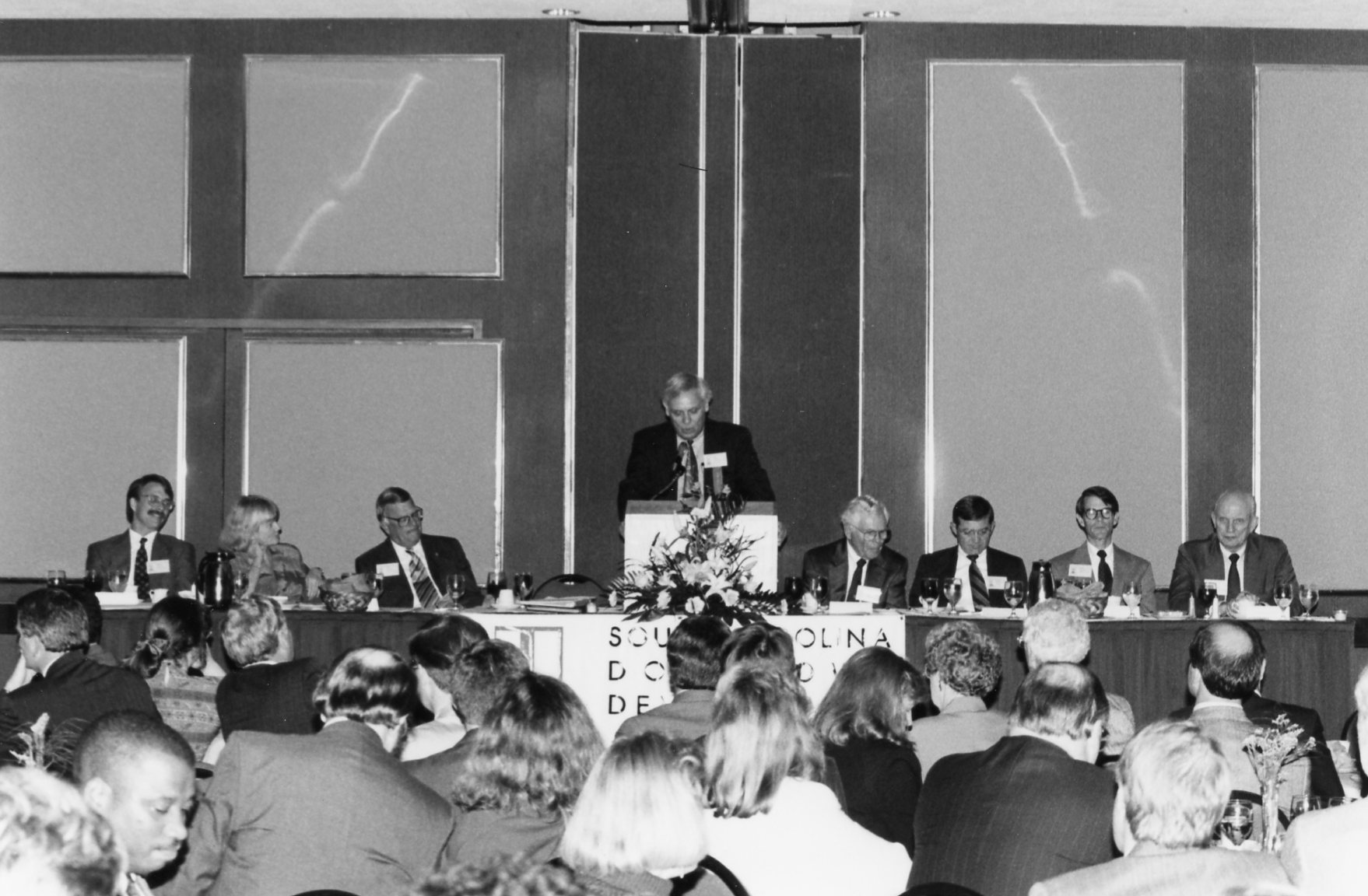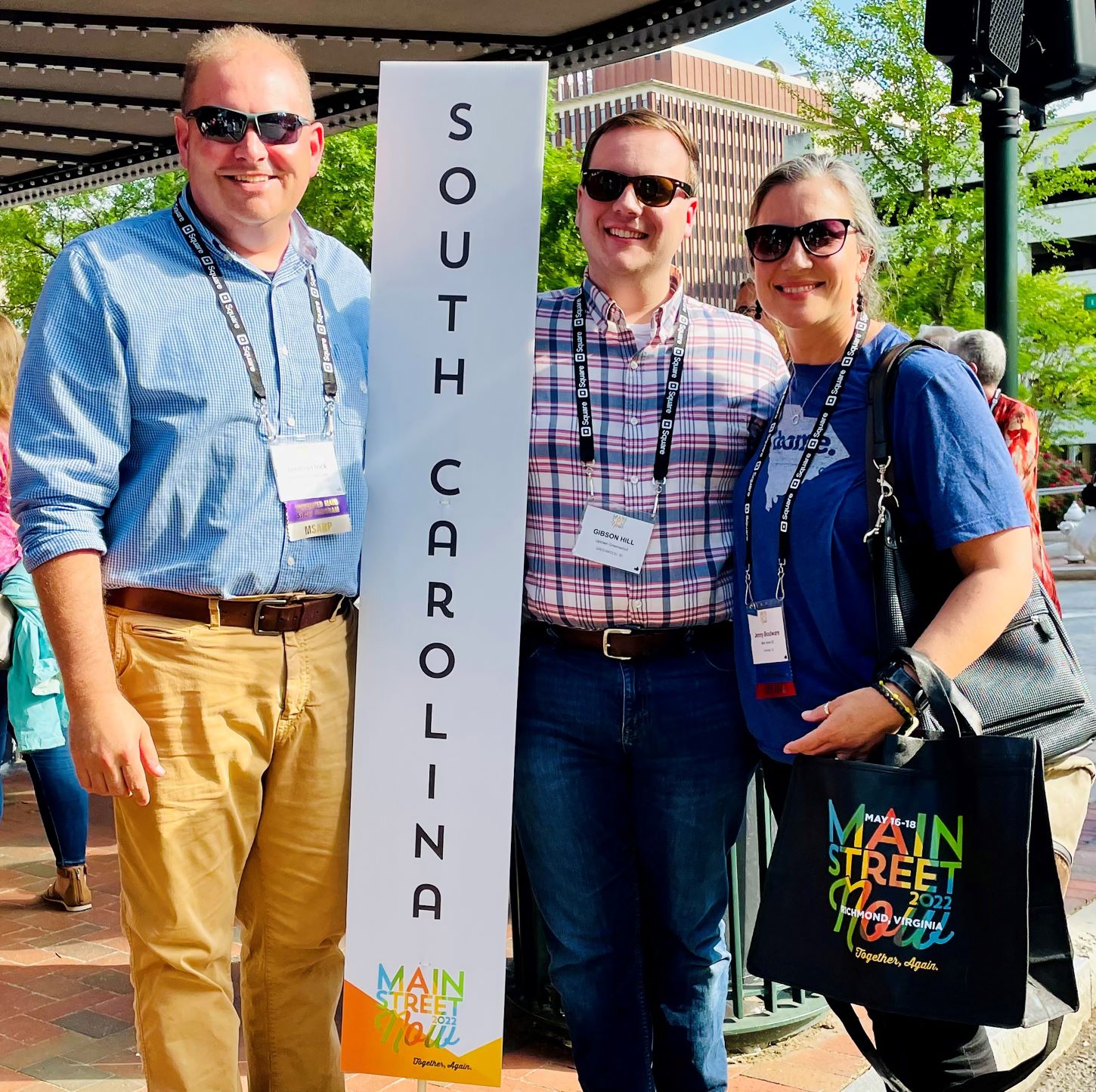Jenny Boulware, the manager of Main Street South Carolina, began working as an intern for the program when she was a graduate student in 1999. She also later served as the executive director of Main Street Laurens for six years.
“I was enchanted by the Main Street magic,” she said. “And I continue to be completely immersed in it.”
That belief in the mission are part of what has helped the statewide Main Street program continue to thrive in the 40 years since it began. Main Street SC is the successor to the SC Downtown Development Association, established in 1983 as part of a national movement to reinvest in downtowns. Growing from that core vision of a statewide network, Main Street SC has continued the work under its current name since 2005. It provides technical assistance and professional guidance to cities and towns looking to revitalize their central business districts through grassroots community-driven economic development and
historic preservation.

SC Downtown Development Director Ben Boozer, center, presents at a
SCDDA meeting in the 1980s.
The organization has gone through name changes, and has seen both its size and scope evolve over four decades, as priorities and economic circumstances have fluctuated. But the work — and the belief in the importance of healthy downtown districts — continues.
That work is happening in towns and cities around the state, where during the past four decades, dozens of communities have paid attention to two principles that guide the Main Street program: what’s good for downtown is good for the greater community; and the downtown improvement effort is about more than events, beautification and historic preservation — it must be tied to economic development.
“The Main Street Approach holistically assesses a community’s bigger picture,” Boulware said. “It’s not a targeted, one-size-fits-all program. Just as the state is geographically rich with mountains and beaches and everything in between, our state’s historic downtowns are home to vastly different assets. The Main Street Approach embraces and celebrates each community’s unique assets.”
There are currently five accredited Main Street programs in South Carolina: Aiken, Florence, Greenwood, Hartsville and Laurens. They are joined by cities and towns in other categories: Aspiring, Classic and Friends of Main Street — a total of 30 participating communities. Main Street South Carolina is a program of the Municipal Association of SC, making it the only program in the nation that is part of a municipal league.
Beppie LeGrand worked as a program assistant and later led the state’s Main Street program. She also served on the boards of the National Trust for Historic Preservation and Main Street America. She credited state program founder Ben Boozer with building a foundation for a successful program.
“Ben started the Main Street program with several other visionaries who recognized that the principles of the national Main Street program could be effective in our state,” LeGrand said. “We continued to slowly build the state program, adding a few new local programs each year. We realized that we needed to practice what we preached — growing any program, state or local, is a process that needs careful nurturing and a watchful eye. ‘Hurry’ was not in our vocabulary. Many of the communities who joined us in the early years remain with the program today. The fact that Main Street South Carolina has only had four managing leaders in 40 years says it all. There has been consistency in leadership, and that speaks volumes to the attention
paid to the communities and the quality of the program.”

Staff from Main Street programs around South Carolina joined in a group art project in
downtown Anderson in the early 2000s. The programs represented included Anderson,
Conway, Laurens, Bennettsville, Aiken and Summerville, appear alongside SCDDA
staff Bill Steiner and Randy Wilson.
Liz Parham was an early recruit to the South Carolina Main Street program, working as a director in Sumter soon after graduating from college. Now serving as the director of the North Carolina Main Street and Rural Planning Center, she spent nearly 35 years working with Main Street programs in the Carolinas.
What she learned at the start — and continues to preach today — is that a downtown is truly a community’s heart and soul.
“From an economic development standpoint, if you’re not taking care of the heart and soul of your community, you’re not going to grow in any other way,” Parham said. “If industries are looking at your community and the downtown district doesn’t look good and doesn’t feel vibrant, those industries aren’t going to come. Economic development really is at the center of what you do.”
While the state Main Street programs started under the arm of the National Trust for Historic Preservation, they differ from the National Trust in an important way: economic development, within the context of historic preservation, is a driving factor.
“We’re not pure preservationists. We believe in preservation, certainly, but we look at the economic development aspects as well. That’s what’s made such a difference in the longevity of the program,” Parham said.
Those thoughts are echoed by Randy Wilson, who spent six years as the staff architect for Main Street South Carolina before leaving in 2005 to start his private firm, Community Design Solutions. He continues to serve as a consultant for the organization.
As part of his work for Main Street, he helps cities and towns with historic buildings and anything else that’s visual — from roadways to landscaping, lighting to signage. He understands the importance of safeguarding the physical structures that give a downtown its uniqueness.
“Preservation sometimes gets a bad rap for being anti-business and all about what’s ‘old,’ and it’s not that way at all. If I had to self-title myself, I would consider myself a practical preservationist,” he said. “It’s important that I give in on certain battles to win the war. And to me, winning the war means we save historic structures, but we adapt them so they can accommodate modern business and retail uses. The mantra we try to live by in Main Street circles is, ‘We aren’t striving for uniformity; we are striving for compatibility.’”
Wilson said he believes the present just might be the “golden age” of downtown revival, pointing to the bustling Soda City Market held each Saturday on Columbia’s Main Street and the total transformation of downtown Greenville, along with the downtown resurgence in smaller cities and towns like Greer, Hartsville and Lexington.
“Enough people have been persuaded that downtown matters,” he said. “’Downtown has a cool vibe to it, especially in the age of a pandemic. I can live and walk and get what I need.”
He also said that leaders can’t lose sight of the fact that downtown revitalization is all about economic development.
“The day we think that preserving, maintaining and enhancing our downtowns is just about beautification is the day that we fail. What’s good for downtown is good for business everywhere in the city,” Wilson said. “I guarantee you there has yet to be a major industry that’s located anywhere near a major metro area in South Carolina that did not request to see the downtown.”

From left: Main Street Laurens Executive Director Jonathan Irick, Uptown Greenwood
Events & Marketing Coordinator Gibson Hill and Main Street SC Manager Jenny Boulware
represent the state at the 2022 Main Street America conference in Richmond, Va.
LeGrand believes Main Street South Carolina is important to the state because it enables residents to have a voice in the future of their communities while working with local leaders to implement planning goals.
“The preservation of local heritage, maintenance of historic structures, support and recruitment of local entrepreneurs, and nurturing community involvement and pride with a focus on the future is a delicate balance,” LeGrand said. “The Main Street program brings the expertise to encourage this balance.”
Boulware always reminds communities of the need for a slow and steady approach to guiding downtown revitalization initiatives.
“It’s natural to want immediate results, but Main Street is focused on incremental and purposeful downtown transformation. Take Downtown Camden and its alley improvements. Each year new elements are added — from pinwheels in the planter boxes to a large butterfly mural and miniature bronze Boykin spaniels. While each of these components do not draw thousands of crowds to downtown, they do create a unique sense of whimsy and fun. They establish downtown as a destination for everyone.”
Since 1983, more than 70 communities have directly benefitted from South Carolina’s Main Street program, bringing economic strength to the state’s downtown commercial districts. South Carolina’s Main Street communities have tracked over $609 million in new investment, more than 5,000 new jobs and over 1,400 historic buildings rehabilitated.
These communities are part of a national movement with a proven track record for celebrating community character, preserving local history, and generating impressive economic returns. Nationwide, over $95 billion has been invested in historic downtown districts.
